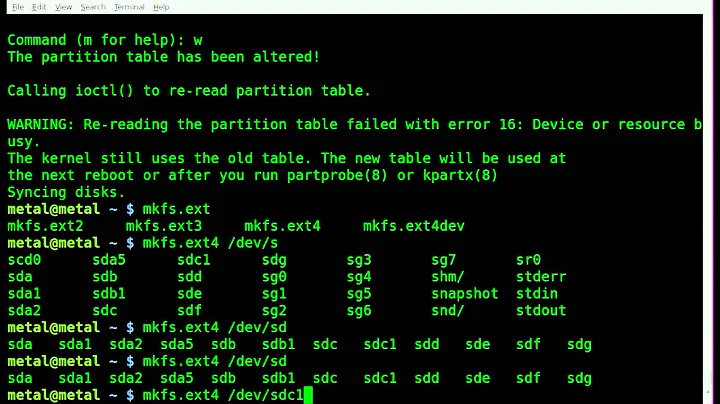How can I mount a partition from dd-created image of a block device (e.g. HDD) under Linux?
Solution 1
Nowadays, there is a better way, no need to use offsets or kpartx anymore:
losetup --partscan --find --show disk.img
mount /dev/loop0p1 /mnt
to free up loop0, use after umount:
losetup -d /dev/loop0
Solution 2
I ran into this problem today and wanted to update the answers just as a reminder for myself. Instead of calculating the offset on your own, you can use a tool that provides you with mountable devices from a dd image: kpartx
http://robert.penz.name/73/kpartx-a-tool-for-mounting-partitions-within-an-image-file/
http://linux.die.net/man/8/kpartx
In the given case, it would need something like
sudo kpartx -a image750.img
sudo mount /dev/mapper/loop1p1 /mount/point -o loop,ro
where loop1p1 stands for the first partition, loop1p2 for the second, etc.
Solution 3
You've got the first part: fdisk -l to find the start offset. Take that number, multiply by 512, and you'll get the offset option to mount. So, for sda1 in your case, 5 * 512 = 2560. Then run the mount:
mount -o loop,offset=2560 -t auto /path/to/image.dd /mount/point
Solution 4
I believe loopmounting is the answer -
sudo mkdir /path/to/dir/
mount -o loop example.img /path/to/dir/
The above should mount it under that directory.
This should unmount it:
umount /path/to/dir
Solution 5
Loopmounting is only part of the answer.
Look at http://wiki.edseek.com/guide:mount_loopback#accessing_specific_partitions_in_the_image for help on specifying the partition. I think mount -o loop,offset=32256 /path/to/image750.img /mnt will work for you. but you really should read the mentioned tutorial.
Related videos on Youtube
Deleted
Updated on September 17, 2022Comments
-
Deleted almost 2 years
I have an image of the entire disk created using dd. The disk structure follows:
kent@cow:~$ sudo fdisk -l Disk /dev/sda: 750.1 GB, 750156374016 bytes 255 heads, 63 sectors/track, 91201 cylinders Units = cylinders of 16065 * 512 = 8225280 bytes Disk identifier: 0x000b8508 Device Boot Start End Blocks Id System /dev/sda1 * 5 90872 729929303+ 83 Linux /dev/sda2 90873 91201 2642692+ 5 Extended /dev/sda5 90873 91201 2642661 82 Linux swap / SolarisThe image was created using:
dd if=/dev/sda of=image750.imgHow would I, if it is possible, mount /dev/sda1 from the image so that I'm able to read the contents?
It's not an option to clone the HDD again, I know how to do it if I had only cloned the single partition by itself. I hope it's still possible with the current image.
-
quack quixote over 14 yearsthe offset looks wrong; that corresponds to a partition start of 63 (<i>63 * 512 = 32256</i>). the offset in baumgart's answer looks more correct for this situation. the link is a good reference, but it'd be a better answer if you took the time to summarize the steps or commands needed for this procedure. thanks!
-
Cutter over 9 yearsOn my Ubuntu 14.04 installation, losetup doesn't provide a --partscan option.
-
 Ciro Santilli Путлер Капут 六四事 almost 8 years@Cutter it was added in util-linux 2.21, Ubuntu 16.04. :-)
Ciro Santilli Путлер Капут 六四事 almost 8 years@Cutter it was added in util-linux 2.21, Ubuntu 16.04. :-) -
 Randy Syring about 6 yearsHaving used
Randy Syring about 6 yearsHaving usedkpartxfirst, which mounts the partitions like/dev/mapper/loop3p1, I just want to point out thatlosetupcreates the devices like/dev/loop0p1. The answer notes that, but I read over it probably 10 times. :/ -
Warren P almost 4 yearsThis is a good example of link rot. That page is gone.
-
mgutt over 3 yearsweb.archive.org/web/20141213021001/http://wiki.edseek.com:80/… or this lists multiple variants to mount tinyapps.org/docs/mount_partitions_from_disk_images.html
-
Iceberg over 2 years
losetup --partscan --find --show disk.imgmight give you/dev/loop1, in which case you'll needmount /dev/loop1p1 /mnt.




